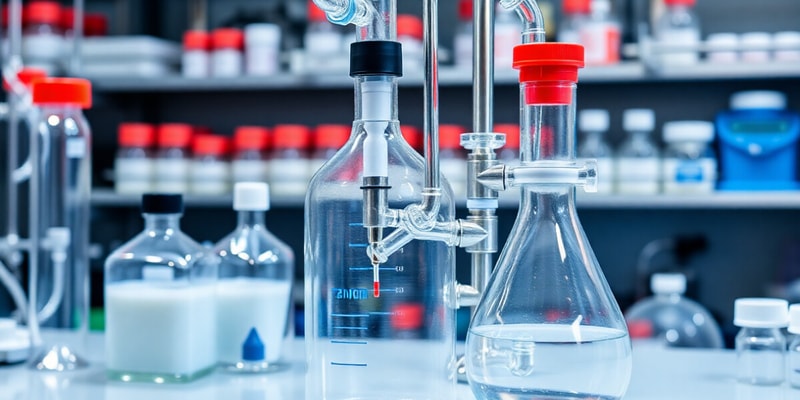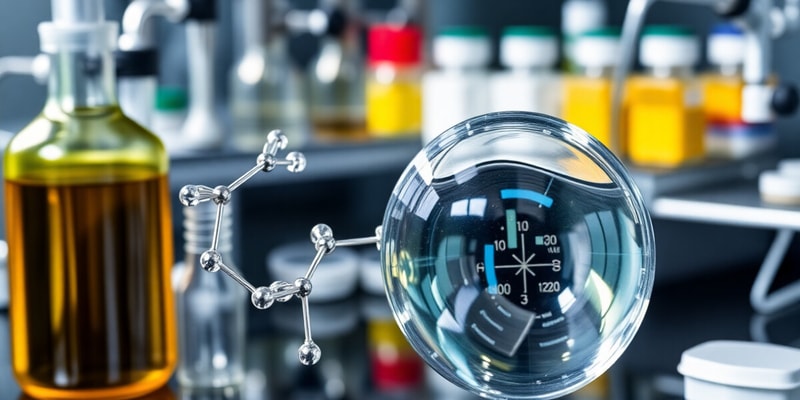Podcast
Questions and Answers
The active drug molecule is referred to as the ______.
The active drug molecule is referred to as the ______.
API
Chemistry, Physics, and ______ chemistry are integral to understanding physicochemical principles.
Chemistry, Physics, and ______ chemistry are integral to understanding physicochemical principles.
physical
The ______ law of thermodynamics relates to the conservation of energy.
The ______ law of thermodynamics relates to the conservation of energy.
first
The process by which drugs bind to proteins in tissues is through ______.
The process by which drugs bind to proteins in tissues is through ______.
Signup and view all the answers
A ______ point represents a unique set of conditions where phases coexist in equilibrium.
A ______ point represents a unique set of conditions where phases coexist in equilibrium.
Signup and view all the answers
The ______ rule is used to understand the behavior of chemical potential in mixtures.
The ______ rule is used to understand the behavior of chemical potential in mixtures.
Signup and view all the answers
The study of how concentration affects hydrogen ion concentration is related to ______.
The study of how concentration affects hydrogen ion concentration is related to ______.
Signup and view all the answers
The second law of thermodynamics introduces the concept of ______ and free energy.
The second law of thermodynamics introduces the concept of ______ and free energy.
Signup and view all the answers
The ______ strength of an ionic solution helps determine the activity of ions.
The ______ strength of an ionic solution helps determine the activity of ions.
Signup and view all the answers
The course PF1010 includes materials such as PDFs of lecture slides and ______ of lectures.
The course PF1010 includes materials such as PDFs of lecture slides and ______ of lectures.
Signup and view all the answers
Thermodynamics is the study of the energy of physical and chemical ______.
Thermodynamics is the study of the energy of physical and chemical ______.
Signup and view all the answers
A ______ formulation is a system of multiple phases and components governed by thermodynamics.
A ______ formulation is a system of multiple phases and components governed by thermodynamics.
Signup and view all the answers
A ______ is a homogenous portion of physical material bounded by interfaces.
A ______ is a homogenous portion of physical material bounded by interfaces.
Signup and view all the answers
In thermodynamics, a ______ is defined as a chemical 'ingredient' of the system.
In thermodynamics, a ______ is defined as a chemical 'ingredient' of the system.
Signup and view all the answers
Examples of equilibrium processes include binding of drugs to ______ or enzymes.
Examples of equilibrium processes include binding of drugs to ______ or enzymes.
Signup and view all the answers
Pharmaceutical analysis often utilizes techniques like ______ chromatography to measure partitioning between phases.
Pharmaceutical analysis often utilizes techniques like ______ chromatography to measure partitioning between phases.
Signup and view all the answers
The ______ is the defined part of the physical world under study in thermodynamics.
The ______ is the defined part of the physical world under study in thermodynamics.
Signup and view all the answers
The rest of the physical world, which includes areas affected by changes to the system, is referred to as the ______.
The rest of the physical world, which includes areas affected by changes to the system, is referred to as the ______.
Signup and view all the answers
Thermal Analysis is used to study ______ transfers in pharmaceutical systems.
Thermal Analysis is used to study ______ transfers in pharmaceutical systems.
Signup and view all the answers
Equilibrium constants are measures of ______ activity in various pharmaceutical processes.
Equilibrium constants are measures of ______ activity in various pharmaceutical processes.
Signup and view all the answers
Components may be partitioned between various ______.
Components may be partitioned between various ______.
Signup and view all the answers
The process is then at ______.
The process is then at ______.
Signup and view all the answers
React a of A with b of B to form ______ and D.
React a of A with b of B to form ______ and D.
Signup and view all the answers
The law of mass action defines the relationship between the concentrations of ______ and products.
The law of mass action defines the relationship between the concentrations of ______ and products.
Signup and view all the answers
The symbol means that the process occurs in ______ directions.
The symbol means that the process occurs in ______ directions.
Signup and view all the answers
Drugs may be partitioned between an aqueous medium and a ______ medium.
Drugs may be partitioned between an aqueous medium and a ______ medium.
Signup and view all the answers
Equilibrium constant (Keq) is defined for the process involving ______ concentrations.
Equilibrium constant (Keq) is defined for the process involving ______ concentrations.
Signup and view all the answers
In the equilibrium expression, ______ stands for the concentration of component ______.
In the equilibrium expression, ______ stands for the concentration of component ______.
Signup and view all the answers
Equilibrium processes are subject to the law of mass ______.
Equilibrium processes are subject to the law of mass ______.
Signup and view all the answers
The equilibrium is dynamic, meaning that the overall amounts of A, B, C, and D stay the same, but the ______ is still ongoing.
The equilibrium is dynamic, meaning that the overall amounts of A, B, C, and D stay the same, but the ______ is still ongoing.
Signup and view all the answers
The definition of the equilibrium constant is represented as 𝐾𝑒𝑞 = [DHAP] / [G3P]. Here, [G3P] is equal to ______.
The definition of the equilibrium constant is represented as 𝐾𝑒𝑞 = [DHAP] / [G3P]. Here, [G3P] is equal to ______.
Signup and view all the answers
The initial concentration of G3P was 0.05 M, and after reaching equilibrium, the concentration was ______.
The initial concentration of G3P was 0.05 M, and after reaching equilibrium, the concentration was ______.
Signup and view all the answers
For the reaction at 25 °C, 𝐾𝑒𝑞 for G3P is calculated to be ______.
For the reaction at 25 °C, 𝐾𝑒𝑞 for G3P is calculated to be ______.
Signup and view all the answers
The equilibrium constant for the isomerisation of glucose-6-phosphate (G6P) to fructose-6-phosphate (F6P) is ______.
The equilibrium constant for the isomerisation of glucose-6-phosphate (G6P) to fructose-6-phosphate (F6P) is ______.
Signup and view all the answers
The concentration of DHAP at equilibrium is calculated to be ______.
The concentration of DHAP at equilibrium is calculated to be ______.
Signup and view all the answers
M is short for ______, which is the unit used to express concentration in this context.
M is short for ______, which is the unit used to express concentration in this context.
Signup and view all the answers
Pharmaceutical systems include medicines and dosage formulations of ______ and excipients.
Pharmaceutical systems include medicines and dosage formulations of ______ and excipients.
Signup and view all the answers
Ligands and receptors, enzymes and substrates/inhibitors are examples of ______.
Ligands and receptors, enzymes and substrates/inhibitors are examples of ______.
Signup and view all the answers
The key issue in pharmaceutical systems is structure and ______.
The key issue in pharmaceutical systems is structure and ______.
Signup and view all the answers
For a reaction, when the equilibrium constant is inverted, it results in 𝐾𝑒𝑞 ______ to 𝐾𝑒𝑞 right → left.
For a reaction, when the equilibrium constant is inverted, it results in 𝐾𝑒𝑞 ______ to 𝐾𝑒𝑞 right → left.
Signup and view all the answers
Study Notes
PF1010 Module Objective
- This module introduces the physicochemical principles of pharmaceutical systems, including formulations of APIs and excipients, drug binding to receptors, enzyme binding to substrates, and cellular structures.
Physicochemical Principles
- These principles involve aspects of chemistry, physics, and physical chemistry that influence the structure, stability, and function of pharmaceutical systems.
Thermodynamics and Pharmaceutical Systems
- Pharmaceutical systems consist of multiple phases and components governed by thermodynamics and process equilibria.
- Examples of equilibrium processes include drug binding to receptors or enzymes, biochemical reactions in metabolism, manufacturing of APIs, and formulation processes.
- Many measures of pharmacological activity rely on equilibrium constants.
Components and Phases in Pharmaceutical Systems
- System: a defined part of the physical world under study.
- Surroundings: the rest of the physical world that is affected by changes in the system.
- Phase: a homogenous portion of physical material bounded by interfaces.
- Component: a chemical ingredient of the system.
Equilibrium in Pharmaceutical Systems
- Pharmaceutical systems can have many components and phases, like APIs, excipients, solid phases, liquids, and gases.
- Components may be partitioned between different phases.
- The system reaches a dynamic equilibrium where the overall amounts of components remain constant, but the processes continue in both directions.
Law of Mass Action and Equilibrium Constants
- The law of mass action describes the relationship between the rate of a chemical reaction and the concentrations of reactants and products.
- The equilibrium constant (Keq) quantifies the relative amounts of reactants and products at equilibrium.
- The value of Keq depends on the stoichiometries of the reactants and products.
Examples of Pharmaceutical Processes and Equilibria
- Drug Partitioning: Drugs can partition between aqueous and lipid mediums, with a partition coefficient (P) describing the equilibrium.
- Biochemical Reactions: Reactions like the isomerization of G3P to DHAP have equilibrium constants that can be calculated from the concentrations of reactants and products.
Structure and Stability of Pharmaceutical Systems
- Key issues in pharmaceutical systems are the structure and stability of components, including APIs, excipients, and biomolecules.
- The structure and stability of pharmaceutical systems are crucial for their efficacy and safety.
Studying That Suits You
Use AI to generate personalized quizzes and flashcards to suit your learning preferences.
Related Documents
Description
Explore the physicochemical principles that govern pharmaceutical systems in the PF1010 module. This quiz covers topics such as drug binding, thermodynamics, and the stability of formulations. Delve into the essential aspects of chemistry and physics that influence drug development and metabolism.




